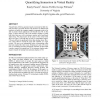Free Online Productivity Tools
i2Speak
i2Symbol
i2OCR
iTex2Img
iWeb2Print
iWeb2Shot
i2Type
iPdf2Split
iPdf2Merge
i2Bopomofo
i2Arabic
i2Style
i2Image
i2PDF
iLatex2Rtf
Sci2ools
SIGGRAPH
1997
ACM
1997
ACM
Quantifying immersion in virtual reality
Virtual Reality (VR) has generated much excitement but little formal proof that it is useful. Because VR interfaces are difficult and expensive to build, the computer graphics community needs to be able to predict which applications will benefit from VR. In this paper, we show that users with a VR interface complete a search task faster than users with a stationary monitor and a hand-based input device. We placed users in the center of the virtual room shown in Figure 1 and told them to look for camouflaged targets. VR users did not do significantly better than desktop users. However, when asked to search the room and conclude if a target existed, VR users were substantially better at determining when they had searched the entire room. Desktop users took 41% more time, re-examining areas they had already searched. We also found a positive transfer of training from VR to stationary displays and a negative transfer of training from stationary displays to VR.
| Added | 07 Aug 2010 |
| Updated | 07 Aug 2010 |
| Type | Conference |
| Year | 1997 |
| Where | SIGGRAPH |
| Authors | Randy F. Pausch, Dennis Proffitt, George H. Williams |
Comments (0)

